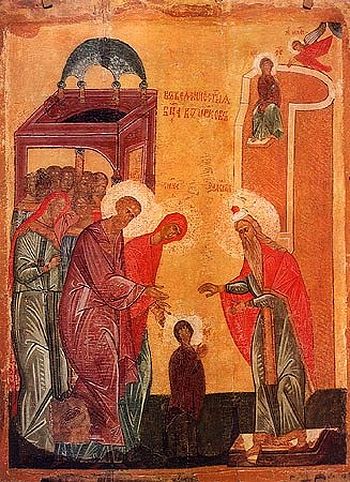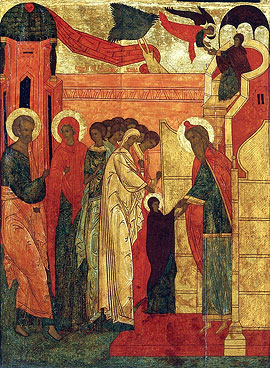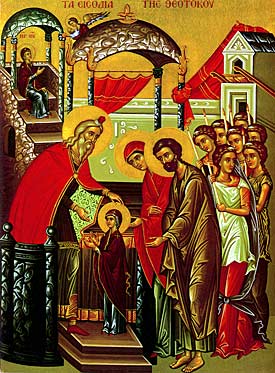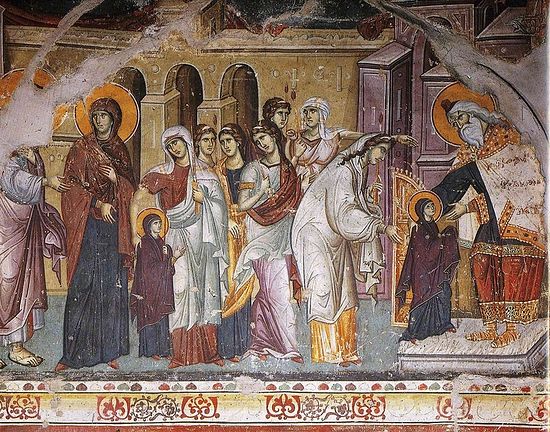If a tree is known by its fruit, and a good tree bears good fruit (cf. Mt. 7:17; Lk. 6:44), then is not the Mother of Goodness Itself, She who bore the Eternal Beauty, incomparably more excellent than every good, whether in this world or the world above? Therefore, the coeternal and identical Image of goodness, Preeternal, transcending all being, He Who is the preexisting and good Word of the Father, moved by His unutterable love for mankind and compassion for us, put on our image, that He might reclaim for Himself our nature which had been dragged down to uttermost Hades, so as to renew this corrupted nature and raise it to the heights of Heaven. For this purpose, He had to assume a flesh that was both new and ours, that He might refashion us from out of ourselves. Now He finds a Handmaiden perfectly suited to these needs, the supplier of Her own unsullied nature, the Ever-Virgin now hymned by us, and Whose miraculous Entrance into the Temple, into the Holy of Holies, we now celebrate. God predestined Her before the ages for the salvation and reclaiming of our kind. She was chosen, not just from the crowd, but from the ranks of the chosen of all ages, renowned for piety and understanding, and for their God-pleasing words and deeds.
ENTRY OF THE MOTHER OF GOD INTO THE TEMPLEe
St. Gregory Palamas,
Entry in the Temple. Icon fragment, 16th century.If a tree is known by its fruit, and a good tree bears good fruit (cf. Mt. 7:17; Lk. 6:44), then is not the Mother of Goodness Itself, She who bore the Eternal Beauty, incomparably more excellent than every good, whether in this world or the world above? Therefore, the coeternal and identical Image of goodness, Preeternal, transcending all being, He Who is the preexisting and good Word of the Father, moved by His unutterable love for mankind and compassion for us, put on our image, that He might reclaim for Himself our nature which had been dragged down to uttermost Hades, so as to renew this corrupted nature and raise it to the heights of Heaven. For this purpose, He had to assume a flesh that was both new and ours, that He might refashion us from out of ourselves. Now He finds a Handmaiden perfectly suited to these needs, the supplier of Her own unsullied nature, the Ever-Virgin now hymned by us, and Whose miraculous Entrance into the Temple, into the Holy of Holies, we now celebrate. God predestined Her before the ages for the salvation and reclaiming of our kind. She was chosen, not just from the crowd, but from the ranks of the chosen of all ages, renowned for piety and understanding, and for their God-pleasing words and deeds.
FEAST OF THE ENTRANCE INTO THE TEMPLE OF OUR MOST HOLY LADY THE THEOTOKOS
The Feast of the Entrance into the Temple of Our Most Holy Lady the Theotokos and Ever-Virgin Mary is celebrated on November 21 each year. The Feast commemorates when as a young child, the Virgin Mary entered the Temple in Jerusalem.
INTRODUCTION
The birth and early life of the Virgin Mary is not recorded in the Gospels or other books of the New Testament, however this information can be found in a work dating from the second century known as the Book of James or Protevangelion.
ENTRY OF THE VIRGIN MARY THE THEOTOKOS INTO THE TEMPLE
The Presentation of Mary
Righteous Joachim and Anna had been granted their wish for a child with a vow to dedicate their child to the service of God. As soon as Mary was weaned from milk they felt an urgency to fulfill the vow they had made to God. When she was two years old her father said, “Let us take her up to the temple of the Lord, that we may pay the vow that we have vowed, lest the Lord depart from us, or perchance, the Lord send us someone to warn us that we have been too long in paying our vow because our offering hath not been received.” But her mother replied, “Let us wait until her third year, so that our daughter might not be at a loss to know her father and also that she might not look for us.” So, they decided to wait another year.
THE ENTRY OF OUR MOST HOLY LADY THEOTOKOS AND EVER-VIRGIN MARY INTO THE TEMPLE
Metropolitan Anthony of Sourozh
Since early days the Church has given to the Mother of God titles of holiness greater than those which are given to any saint. She is called the All-holy, Panagia. We venerate Her as One who is greater and holier than the Cherubim and the Seraphim, greater than the angels of God who, endowed with vision, can see, contemplate and adore, greater than the angels of God who are, as it were, the throne of the Most High. Because the ones as the others see, worship, serve God as their Lord, as their Master, and yet somehow they remain farther from Him than She, who in Her exceeding holiness has become the kin of God, has become the Mother of the Incarnate Word, who is the Bride, the perfect revelation of what the whole creation is called to be and to become.
ENTRANCE OF THE MOTHER OF GOD INTO THE TEMPLE
When the Most-holy Virgin Mary reached the age of three, her holy parents Joachim and Anna took her from Nazareth to Jerusalem to dedicate her to the service of God according to their earlier promise. It was a three-day journey from Nazareth to Jerusalem but, traveling to do a God-pleasing work, this journey was not difficult for them. Many kinsmen of Joachim and Anna gathered in Jerusalem to take part in this event, at which the invisible angels of God were also present. Leading the procession into the Temple were virgins with lighted tapers in their hands, then the Most-holy Virgin, led on one side by her father and on the other side by her mother. The virgin was clad in vesture of royal magnificence and adornments as was befitting the “King’s daughter, the Bride of God” (Psalm 45:13-15). Following them were many kinsmen and friends, all with lighted tapers. Fifteen steps led up to the Temple. Joachim and Anna lifted the Virgin onto the first step, then she ran quickly to the top herself, where she was met by the High Priest Zacharias, who was to be the father of St. John the Forerunner. Taking her by the hand, he led her not only into the Temple, but into the “Holy of Holies,” the holiest of holy places, into which no one but the high priest ever entered, and only once each year, at that. St. Theophylact of Ohrid says that Zacharias “was outside himself and possessed by God” when he led the Virgin into the holiest place in the Temple, beyond the second curtain-otherwise, his action could not be explained. Mary’s parents then offered sacrifice to God according to the Law, received the priest’s blessing and returned home. The Most-holy Virgin remained in the Temple and dwelt there for nine full years. While her parents were alive, they visited her often, especially Righteous Anna. When God called her parents from this world, the Most-holy Virgin was left an orphan and did not wish to leave the Temple until death or to enter into marriage. As that would have been against the Law and custom of Israel, she was given to St. Joseph, her kinsman in Nazareth, after reaching the age of twelve. Under the acceptable role of one betrothed, she could live in virginity and thus fulfill her desire and formally satisfy the Law, for it was then unknown in Israel for maidens to vow virginity to the end of their lives. The Most-holy Virgin Mary was the first of such life-vowed virgins, of the thousands and thousands of virgin men and women who would follow her in the Church of Christ. (Prologue of Ohrid)
The Entry of our Most Holy Lady Theotokos and Ever-Virgin Mary into the Temple

Since early days the Church has given to the Mother of God titles of holiness greater than those which are given to any saint. She is called the All-holy, Panagia. We venerate Her as One who is greater and holier than the Cherubim and the Seraphim, greater than the angels of God who, endowed with vision, can see, contemplate and adore, greater than the angels of God who are, as it were, the throne of the Most High. Because the ones as the others see, worship, serve God as their Lord, as their Master, and yet somehow they remain farther from Him than She, who in Her exceeding holiness has become the kin of God, has become the Mother of the Incarnate Word, who is the Bride, the perfect revelation of what the whole creation is called to be and to become.
THE ENTRY OF THE THEOTOKOS INTO THE TEMPLE
 The oikonomia of our salvation began with the very creation of the world. It is not by chance that the fourth Gospel does not commence with a genealogy of our Lord but takes us back to the very beginning. All things from the beginning to the end, from the alpha to the omega are part of God’s oikonomia for our salvation, God’s providential ordering of our salvation. Man was created that he may participate in the Divinity of his Creator by first participating in his own perfection. We are taught by the Fathers that man was created for perfection. Adam was offered perfection but fell victim to the guile of the serpent. God's plan could not be frustrated and the Lord prepared the world for another Adam who would rescue the offspring of the first Adam.
The oikonomia of our salvation began with the very creation of the world. It is not by chance that the fourth Gospel does not commence with a genealogy of our Lord but takes us back to the very beginning. All things from the beginning to the end, from the alpha to the omega are part of God’s oikonomia for our salvation, God’s providential ordering of our salvation. Man was created that he may participate in the Divinity of his Creator by first participating in his own perfection. We are taught by the Fathers that man was created for perfection. Adam was offered perfection but fell victim to the guile of the serpent. God's plan could not be frustrated and the Lord prepared the world for another Adam who would rescue the offspring of the first Adam.Entering into the Inner Mystery: the Presentation of the Most Holy Mother of God to the Temple
On the 21st of November/4th December, the Orthodox Church celebrates the festival of the Presentation or the Entry, the Eisodos, the Entrance, of the Mother of God, Mary, Christ’s Mother, in the Temple. In his book, The Meaning of Icons, Vladimir Lossky with Ouspensky, Leonid Ouspensky, Vladimir Lossky writes that this festival “does not belong to the most ancient feasts of the Church. None the less,” he writes, “it must be earlier than the end of the VIIth century, since St. Andrew of Crete [bears witness that it was known] at Jerusalem at [that time].”
ENTRY OF THE HOLY THEOTOKOS INTO THE TEMPLE
The feast of the Entry of the Holy Theotokos into the temple is a marvelous model of our entry into the Heavenly Kingdom. The church itself symbolizes the Kingdom of God on earth. In church we see the altar table, which is like a throne on which the Lord God sits, just as He does on His heavenly throne. In church, through the partaking of holy communion, we become united with the Lord Himself. In church, as in heaven, we are surrounded by hosts of angels and saints. In church, by means of the divine services we glorify God, as do the angels and saints in heaven.
Sermon on Gratitude
Metropolitan Anthony Sourozh
17 December 1989
In the name of the Father, the Son and the Holy Ghost.
Ten lepers came to the Lord; ten men who were ritually unclean and therefore, ritually rejected by their community, unable to attend the common worship of the Temple, unable to come near the habitations of men; and unclean also in the eyes of men because their sickness could be transmitted to others: others could become impure, others could be sick unto death.
They came to Christ and stood afar off because they knew that they had no right to come near, to touch Him as had done the woman who had an issue of blood and who had been healed. From afar off they cried for mercy, and the Lord healed them; He sent them to the priests in order to be ritually cleansed. Ten of them went, and nine never came back. One of them, discovering on his way that he was healed, let go of every other concern but his gratitude to Him that had restored him to wholeness. He came back and thanked the Lord, and the Gospel tells us that this man was a Samaritan, a man who was outside of the Hebrew community, a man who had no rights within the people of Israel, a man who was not only a stranger, but a reject.
Subscribe to:
Posts (Atom)







